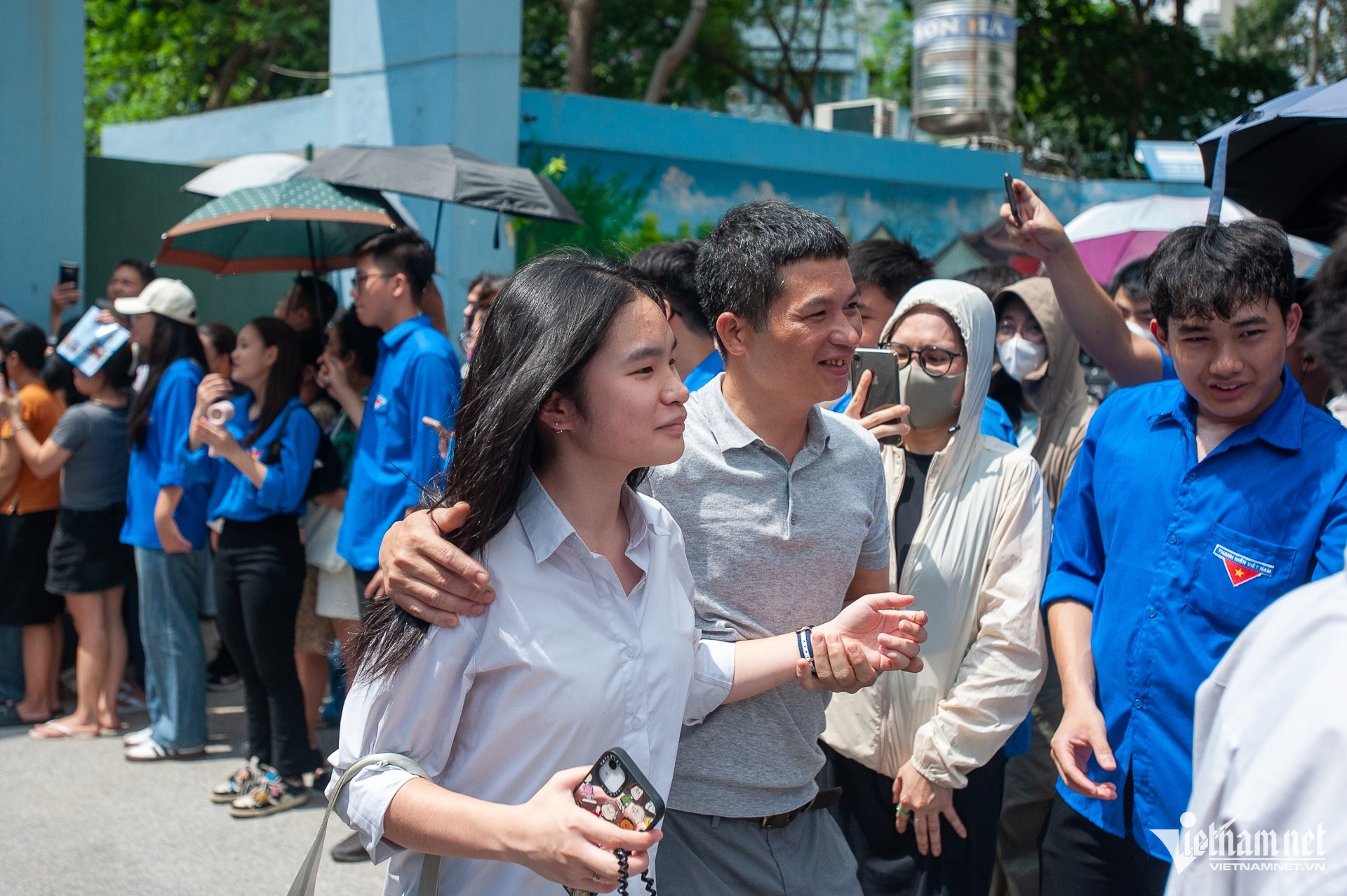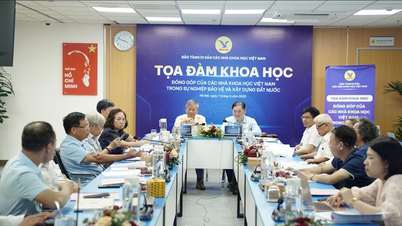Commenting on the 2025 Hanoi 10th grade Math exam, sharing with VietNamNet , Ms. Dinh Thi Hong Hue , Head of the Natural Science Group of To Vinh Dien Secondary School (Dong Da District, Hanoi) assessed that this year's exam ensures that it is suitable for students, with clear content that closely follows the goals and requirements of the 2018 General Education Program.
“The test has clear differentiation, suitable for the goal of assessing students' abilities. The questions are arranged from easy to difficult, helping students to achieve high scores if they have a solid grasp of basic knowledge and the ability to think logically. With this test, students with good thinking skills will be able to develop their abilities. The test focuses on problems related to reality, requiring students to know how to apply knowledge to specific situations. The questions not only test calculation ability but also evaluate the ability to analyze and solve problems in life,” Ms. Hue commented.

According to Ms. Hue, the exam consists of 5 lessons with full knowledge of arithmetic, algebra, geometry, statistics, probability and practical applications according to the sample structure announced by the Department of Education and Training, so students with a firm grasp of basic knowledge will be able to do the test. Average students can achieve a score of 6.5-7.0 or higher.
The exam retains 60-70% of the traditional structure but has innovations in content and question-making methods, helping to evaluate students more comprehensively. The difficulty of the exam is moderate, with clear differentiation.
With the knowledge of statistics and probability, this is a new knowledge in the program included in lesson 1. The knowledge tested in this problem does not cause difficulty or puzzle students.
Geometry and measurement knowledge circuit, testing knowledge of plane geometry and solids in practice. Question 2 (lesson IV) is still a difficult question to classify students. Exercises on solids in practice are expanded and go deeper.
Ms. Nguyen Thi Oanh, head of the Math subject for secondary school students at Phenikaa Secondary School - High School, assessed that the Math exam closely followed the format structure and sample exam published by the Department of Education and Training. The exam still had differentiation to ensure the requirements and nature of a 10th grade high school entrance exam.

Regarding the scope of knowledge and difficulty, Ms. Oanh said that the exam structure still includes 5 major problems, each problem consists of many small ideas arranged in order from easy to difficult. These types of problems are very familiar to candidates, so they are not confusing or confusing. Although the exam has a slight decrease in difficulty compared to the sample test, there is still good differentiation.
Specifically, question 1 is a familiar form of statistical probability and does not cause difficulty for candidates when doing the test.
Question 2 maintains the same structure and format. The third sub-question is about solving inequalities. Candidates need to pay attention to the determination condition and the largest positive integer condition to find x = 3.
Question 3 is a familiar type of question and the problem structure is similar to the sample test, including questions to solve problems by setting up a system of equations/equation related to motion and percentage (increase, decrease in percentage). According to Ms. Oanh, candidates need to be able to analyze the question, choose keywords and key data to solve the problem. In particular, in the third point, candidates need to apply Viet's theorem to process or directly solve the solution of the equation to find the value of m.
Question 4 is similar to the sample exam structure, the first question is about spatial geometry to calculate the lateral area of a cylinder and the second question is a practical question about volume. The second question is a geometry problem with the types of problems appearing in the questions being familiar types such as proving that a quadrilateral is inscribed, proving that the bisector of an angle, and geometrical equality. The third part of the problem proving that two lines are perpendicular is always a difficult question, intended to classify candidates.
Question 5 is a problem that tests the practical application of knowledge about inequalities and is a classification question of the test. The problem is less difficult and to solve the problem, candidates need to flexibly apply the skills of transforming expressions and applying inequalities appropriately and at the right time with the given data.
Overall, Ms. Oanh said that the test was less difficult and did not challenge students. “It is expected that the average score of candidates will be around 7 points,” Ms. Oanh said.
Ms. Dinh Tuyet Trinh, Deputy Head of the Math Group of Lomonosov Secondary and High School, also commented that the exam questions were basic, good, and not too challenging.
“The exam has been strongly innovated in structure and content, some questions are closely linked to practical elements in accordance with the innovation spirit of the 2018 General Education Program (question I; question III, part 2; question IV, part 1b; question V).
As expected by teachers and grade 9 students, the exam was suitable for students, not difficult for them; the questions were coherent, clear, the language was easy to understand, clear, and highly differentiated. The knowledge included in the exam mainly focused on the grade 9 program, the exam format was exactly like the Department's sample exam. Therefore, if students have basic background knowledge and have practiced carefully, they can easily get 7 and 8 points. Besides, the exam still has challenging questions for 9 and 10 points in question c of the Synthetic Figure exam and in the last question of the exam (question V)", Ms. Trinh analyzed.
According to Ms. Trinh, this year's Math exam has many changes and is different from previous years' exams.
Specifically, in terms of structure, there are 5 big questions, each big question has many small questions. Accordingly, the score for each question is also divided into smaller parts. This is beneficial for students, if a student gets any question wrong, he/she will not lose much points.
Regarding the number of questions, previously it was 12, this year the number has increased to 14. Thus, more and more diverse knowledge will be tested, helping students to develop their full potential, in accordance with theeducational goals of the new program.
In addition, there are new points in content such as: adding problems with statistics, probability, and spatial geometry that not only simply apply formulas like every year but also require students to solve problems in real life.
“Question V of the exam is in the form of a practical problem, not as monotonous as before. The exam does not give ready-made mathematical expressions, but through a practical problem, students must find their own mathematical inequalities, from which they can evaluate and find the largest value... In short, this year's math exam ensures basic knowledge, is not too challenging, and still classifies students very well,” said Ms. Trinh.
With this test, Ms. Trinh predicts that the candidates' scores will be concentrated at 7 to 8; there will be many 9s and few 10s.
Source: https://vietnamnet.vn/de-thi-mon-toan-lop-10-ha-noi-2025-gan-voi-thuc-te-de-dat-diem-7-tro-len-2409278.html























































































![[OCOP REVIEW] Tu Duyen Syrup - The essence of herbs from the mountains and forests of Nhu Thanh](https://vphoto.vietnam.vn/thumb/402x226/vietnam/resource/IMAGE/2025/6/5/58ca32fce4ec44039e444fbfae7e75ec)







Comment (0)